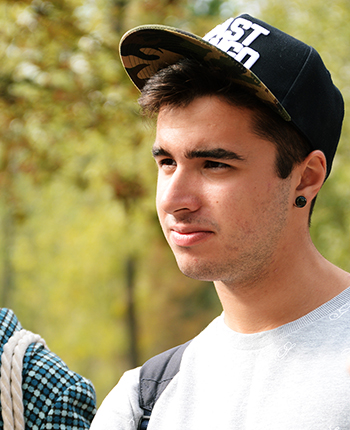
Zhenya Bilotsky
A lot of pain is firmly attached to stories and testimonies of genocide. This in mind, Zhenya Bilotsky, a high school student from a Jewish school in Ukraine, yearned to do the stories of the survivors of the Babi Yar ravine massacre in Ukraine justice with his involvement in the new Babi Yar IWalk - an educational program that put on a walk around the ravine guided by testimony clips from the Visual History Archive.
Having been to the site before with both his family and his school, Bilotsky knew the ravine’s history - in just one week in 1941, SS, German police units and their auxiliaries shot nearly 34,000 Jews from Kiev to death. It was one of the largest mass murders at a single location during World War II, paving the way for tens of thousands of Roma, Communist and Soviet prisoners to be killed in the same fashion in the subsequent months.
For the over 100,000 killed in total at the ravine, 100 testimonies on the subject live on in the Visual History Archive. Along the IWalk, participants - high school students and community members - were able to walk through the historic site and through the Babi Yar memorial while watching those testimony clips from the Visual History Archive on tablet devices.
One of 10 high school students and five young educators trained by USC Shoah Foundation Ukraine regional consultant Anna Lenchovksa to lead the Babi Yar IWalk, Bilotsky was drawn to the program after hearing some of the moving testimonies.
“I was invited by Anna Lenchovska and got very interested in the IWalk,” Bilotsky said. “I was excited to learn new facts, watch testimonies of survivors and rescuers and teach what I had learned to other people.”
In addition to the clips participants watched on the tablet devices - which cover the history of Babi Yar and both pre-war and occupied Kiev, the stories of killing and of survival, the commemoration and the denial - participants heard from and got to ask questions to the interns leading the walks.
Bilotsky said the interactive nature of the IWalk helped make a more powerful impact on the participants.
“Kids, and not only kids, should know history,” Bilotsky said. “And especially the history of the place where they live. On the IWalk, they learned about the lives of Jewish survivors Dina Levina and Lyudmila Tkach. I think our participants liked to know the real story from an eyewitness, seeing their emotions and feelings. It was much better than just reading a dry text from a schoolbook.”
Biltosky and other students were all recruited by Lenchovska to lead the IWalks because of their work with TolerSpace, a Kiev-based NGO developed in 2013 as part of a series of projects promoting tolerance under the Congress of Communities of Ukraine, to create an educational space around discussion of human rights and tolerance.
As a guide, Bilotsky went through training with other students under Lenchovska, which prepared him to lead some IWalks between Sept. 26 and Oct. 7. Although he was concerned that weather might hurt their success, and that he might not present the information engagingly enough, Bilotsky said the IWalk went well.
“I liked everything [about the IWalk],” Bilotsky said. “I want to invite my school to the IWalk.”